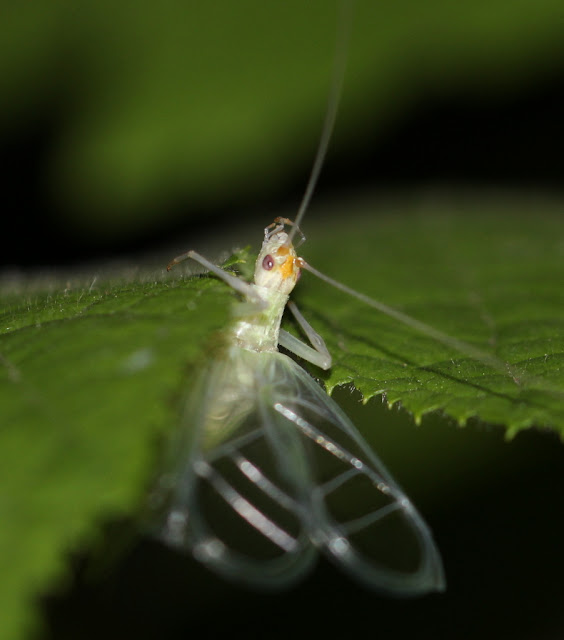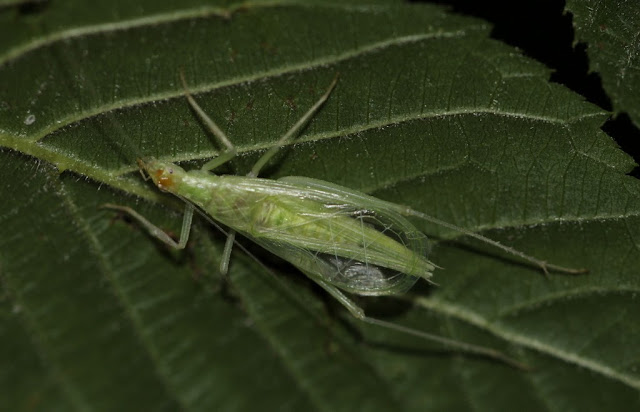“Isn’t there a cricket that can tell the temperature?” I am asked this question not only in my programs and classes, but even when I am simply out surveying singing insects in various parks. Actually, all our singing crickets and katydids are affected by the temperature, and their songs are faster and higher when it is warm and lower and slower when the weather is chilly. It’s rather interesting to hear the entire ensemble rise in pitch and tempo on warm, humid nights and drop together as the temperature falls.
But the cricket that people are asking about is one whose pitch and tempo are exceptionally clear: the Snowy Tree Cricket (Oecanthus fultoni). Its steady, pulsating rhythm sounds almost as regular as a metronome.
The most common temperature calculation formula I’ve found is simply adding 40 to the number of chirps the cricket makes in 13 seconds. Other variations are pretty similar, and I find this one to be the easiest to remember. It works pretty well!
If two crickets are a little apart and one is in a slightly warmer – or cooler – microclimate, they will sing at slightly different pitches and be a little out of sync. The cricket next to the house may be a little warmer than the ones in the back of the yard, and his pitch and temperature may therefore be a bit higher and faster.
Here is Snowy Tree Cricket at about 62 degrees in our back yard. Nearby is another that’s in a different position in a different shrub or vine. Their pitches are very close, but perhaps you can tell that the second one’s song it just a bit higher. The third part of the recording is when my microphone is more or less equally spaced between them – I think the subtle pitch difference will be more obvious now. They also became slightly out of sync over time because one was singing just a bit faster. The air temperature was about 62 degrees, but it was obviously a bit different for each of these individuals. A third cricket a bit farther away was on the same pitch and in sync with the first cricket.
As is so often the case with singing insects, it is easier to hear them than to find them. Snowy Tree Crickets seem to be quite fond of grape vines and blackberry tangles. We often have one singing in the native honeysuckle on our back porch, and the ones in the back of our yard are primarily in blackberries. Another seems to be in a dogwood right next to my studio window this year. (All the photos and recordings in the post are from our back yard.)
As you can see, they will often sing between two leaves, in the notch of a leaf, or even in a hole in a leaf.
If you’re lucky enough to actually locate one of these singers, you’ll see that they are a pale green with reddish-orange accents on their heads – very beautiful insects!
All of our tree crickets except the Two-spotted are members of the genus Oecanthus. Some are easy to distinguish by their songs, and others sound similar to at least one other member of their genus. The definitive identifier is actually the pattern of spots at the base of the antenna.
Of course, seeing this feature is not without its challenges. The insects are small, the base of the antenna much smaller, and the spots….but with considerable amount of luck and macro, it sometimes is possible. Look:
These aren't his eyes - those are on the side of his head. These are the antenna spots, and this is the Snowy Tree Cricket pattern.
But you won’t need antenna spots for this species – their lovely song is quite distinctive. Even when more crickets and katydids are singing, as they are in this recording, the Snowy Tree Cricket's steady rhythm will help you hear that song in the insect ensemble’s dense texture. Here's our back yard a few years ago when the temperatures were much warmer than this year. Therefore, the Snowy Tree Cricket song is considerably higher and faster.
You definitely can learn this cricket's song - just keep in mind that the pitch and tempo fluctuate with the temperature.






Very informative but when I was young I was told by my grandparents that you could also use the song of the cicada to find out the temperature. Is that true? If so what would the formula be?
ReplyDeleteHi, Ann - I've never heard of being able to tell the temperature by a cicada's song. Crickets and katydids sing higher in pitch and faster in tempo when warm, and, not surprisingly, lower in pitch and slower in tempo when cold. It's easiest to perceive in the Snowy Tree Cricket's song because it is so rhythmic and so regular.
DeleteMy Godfather had told me the same thing. Unfortunately I cannot remember.
Delete